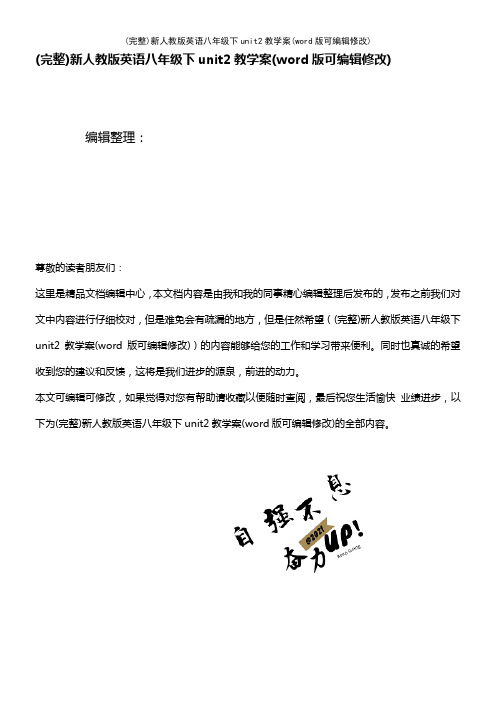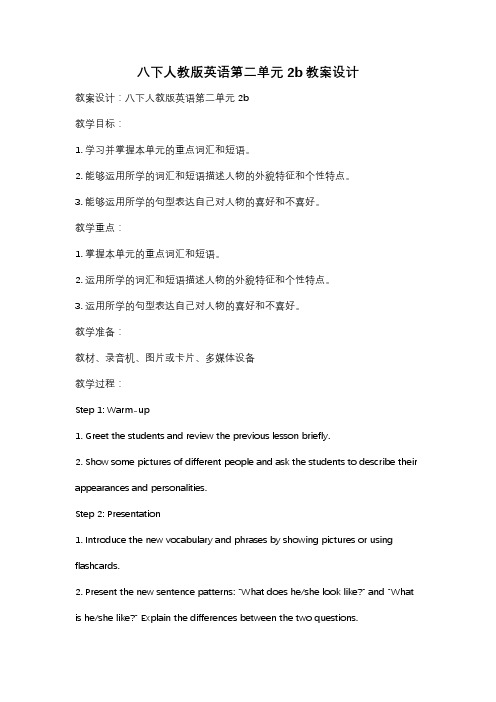人教新目标版八年级英语下册Unit 2 听说课教学设计(公开课教案)
人教新目标版八年级英语下册Unit2SectionB1a-1e听说课公开课课件课件

Test yourself !
Preview test
Task 2. Fill in the blanks. 注意:名词单复数,动词时态(三单,
过去式) 结构(to do\doing sth.)
A boy _t_a_k_e_s_a_f_te_r__(像) Ma Yun.
His bike’sw_h_e_e_l_s_(轮子) are _b_r_o_k_e_n_(坏了).
Step 4 post-reading
Task 1: Retell the passage according to the pictures.
① found
③ gave away
② fixed up
④ has run out of
I have run out of money. Could you help me?
①take after 指的是“(在外貌、性格方面)与…像”不管是名词还是 代词只能放在其后,通常用于有血缘关系。 ②look like “长得像,看起来像”,(只指外表) ③be like “像…”,多指性格像,也可指外表像。 ④be similar to“与…类似”,一般都是在相近似的物品和情境的对比。 ⑤ be the same as“与…完全相同”。
wheels.
TF
2. Jimmygasveellasway bikes.
TF
3. Jimmy takes after his mfaoththerer. T F
4. Jimmy has run out of money. T F
Task 2 Listen again and fill in the blanks.
What can you see in the pictures? Try to describe them.
人教版英语八年级下册Unit2SectionB(2a2e)教学设计

2.阅读理解:选取一篇与冒险相关的文章,设计5-10道阅读理解题,要求学生完成。问题类型包括细节理解、推理判断和主旨大意等,以检验学生对阅读策略的掌握。
-对于基础较好的学生,可以设置更具挑战性的任务,如撰写小短文或进行深入讨论。
4.阅读策略训练:通过指导学生预习、课堂讨论和课后复习,培养学生的阅读策略。
-在预习阶段,学生通过完成预测任务来激活背景知识。
-在课堂讨论中,引导学生通过问题解答和总结来加深对文本的理解。
-课后复习时,鼓励学生运用所学策略进行自我检测和提升。
人教版英语八年级下册Unit2SectionB(2a2e)教学设计
一、教学目标
(一)知识与技能
本章节主要是人教版英语八年级下册Unit 2 Section B(2a-2e)的内容,旨在帮助学生掌握以下知识与技能:
1.能够理解和运用与本单元主题相关的词汇和短语,如"adventure", "safety", "explore", "in case", "as well as"等。
5.听力技能培养:通过多样化的听力练习,如听对话、短文并完成相关任务,提高学生的听力技巧。
-设计梯度性的听力任务,从简单的信息捕捉到复杂的推理判断,逐步提升学生的听力能力。
6.情感态度培养:在教学过程中,注重学生情感态度的引导,鼓励他们勇敢面对挑战,培养团队合作精神。
人教版英语八年级下册Unit2听说课教案

(7)写下,记下______________(8)张贴_____________________
(9)打电话__________________(10)建立__
三、【教师点学】&【组内研学】WhileListening
(4)Pair work: Practice the conversations using the information in 1b.
Listening practice (2a-2b)
(1). Listen for the first time. Please listen to the recording and choose the main idea of the conversation.
(3). Group work.
T: We’ll have a school clean-up tomorrow. We need to come up with a plan. What would you like to do? Talk about it in your group and come up with a plan.
(3) Grammar Structure :master the structure“verb+adv.”
2.AbilityAims: Enable students to talk about how to help the other people.
3.MoralAims:Students could help some necessary things.
中学部教师教学案
年级学科:八年级英语学科 任课教师:
人教版八年级英语下册Unit2教学设计

7.评价机制:采用多元化的评价方式,如自评、互评、教师评价等,关注学生的全面发展。
8.教学反思:在教学过程中,教师应不断反思和调整教学策略,以提高教学效果。
四、教学内容与过程
(一)导入新课
1.教学活动:教师展示一幅描绘成功人士的图片,引导学生观察并思考:“What does this picture remind you of? Can you guess who this person is?”
4.学生对于成功人士的故事有一定的兴趣,但可能对背后的努力和付出认识不足,需要教师引导他们正确看待成功,培养他们努力拼搏的精神。
5.学生在情感态度方面,部分学生对自己缺乏信心,容易受到挫折。教师在教学过程中应关注学生的情感需求,鼓励他们勇敢面对困难,树立自信心。
三、教学重难点和教学设想
(一)教学重难点
3.能够运用所学词汇和语法,进行简单的英文演讲和对话,提高英语口语表达能力。
4.能够阅读并理解关于成功人士的故事,提取关键信息,分析成功的原因。
5.掌握基本的写作技巧,如文章结构、过渡词的运用,能撰写一篇关于自己或他人成功经历的小短文。
(二)过程与方法
在本章节的教学过程中,学生将通过以下方法培养英语学习能力:
3.阅读作业:学生需阅读一篇关于成功人士的英文文章,并完成相关的阅读理解练习,如填空、选择、问答等。文章应选自可靠的英文资源,难度适中,以增加学生的阅读量,提高阅读理解能力。
目标:通过阅读拓展知识,增强学生对成功人士及其故事的理解,提高阅读分析能力。
4.小组作业:学生以小组为单位,共同探讨一个成功主题,如“努力与成功的关系”,“如何面对失败”等,并制作成PPT或海报,进行课堂展示。
新人教版英语八年级下unit2教学案(2021年整理)

(完整)新人教版英语八年级下unit2教学案(word版可编辑修改)
编辑整理:
尊敬的读者朋友们:
这里是精品文档编辑中心,本文档内容是由我和我的同事精心编辑整理后发布的,发布之前我们对文中内容进行仔细校对,但是难免会有疏漏的地方,但是任然希望((完整)新人教版英语八年级下unit2教学案(word版可编辑修改))的内容能够给您的工作和学习带来便利。
同时也真诚的希望收到您的建议和反馈,这将是我们进步的源泉,前进的动力。
本文可编辑可修改,如果觉得对您有帮助请收藏以便随时查阅,最后祝您生活愉快业绩进步,以下为(完整)新人教版英语八年级下unit2教学案(word版可编辑修改)的全部内容。
Unit 2 Lesson 1 Section A 1a—1c
Unit 2 Lesson 2 Section A 2a-2d
Unit 2 Lesson 3 Section A 3a-3c
Unit 2 Lesson 4 Section A 4a—4c
Unit 2 Lesson5 Section B 1a-1e
Unit 2 Lesson 6 Section B 2a—2e
Unit 2 Lesson 7 Section B 3a-Self Check。
人教版八年级英语下册Unit2优秀教学案例

(三)学生小组讨论
1.将学生们分成小组,每组分配不同的任务,如讨论交通方式的优势和劣势,并用自己的语言进行描述。
2.组织小组竞赛,如“最佳小组讨论”、“最佳角色扮演”等,激发学生们的团队合作精神和竞争意识。
3.鼓励学生们在小组内进行互相评价和反馈,培养他们客观评价他人和自我反思的能力。
(四)总结归纳
1.邀请每个小组的代表分享他们的讨论成果,让学生们展示自己在小组合作中的学习成果。
2.总结学生们在课堂上学到的知识,如交通方式的英文表达、一般现在时的运用等,确保学生们能够掌握重点知识。
3.强调学生在团队合作中的表现,鼓励他们继续保持并不断提高团队合作能力。
人教版八年级英语下册Unit2优秀教学案例
一、案例背景
本案例背景以人教版八年级英语下册Unit 2 "How do you get to school?"为例。本节课主要围绕学生的日常上学交通方式进行学习,通过介绍不同交通方式,让学生能够运用一般现在时描述自己的上学方式,并能够询问他人如何去学校。
在教学过程中,我以学生实际生活为切入点,通过展示学生们熟悉的上学场景,引发他们的共鸣,激发学习兴趣。同时,结合课程内容,我设计了一系列的有针对性的教学活动,如小组讨论、角色扮演等,让学生在真实的语境中运用英语,提高他们的语言表达能力。
(三)小组合作
1.将学生们分成小组,每组分配不同的任务,如角色扮演、讨论交通方式的优势和劣势等,让学生们在小组合作中互相交流、讨论。
2.组织小组竞赛,如“最佳小组讨论”、“最佳角色扮演”等,激发学生们的团队合作精神和竞争意识。
3.鼓励学生们在小组内进行互相评价和反馈,培养他们客观评价他人和自我反思的能力。
人教新目标八年级英语下册Unit2SectionB(2a2e)Reading优秀教学案例

问题导向教学策略能够激发学生的思维,培养学生解决问题的能力。在本节课中,我设计了一系列问题,引导学生深入思考和探讨。例如,在阅读环节,我提出了关于文本细节的问题,如“When did they go on the spring outing? What did they do?”等,帮助学生理解文本内容。同时,我还设计了开放式问题,如“Can you describe your most memorable spring outing?”,让学生运用所学知识进行思考和回答。
2.培养学生积极的学习态度,让他们相信自己可以通过努力达到学习目标;
3.培养学生合作、探究的学习态度,让他们学会与人合作,善于发现问题、解决问题;
4.通过描述春游经对文本内容的理解和讨论,培养学生对不同文化的尊重和理解,提高他们的跨文化交际能力。
三、教学策略
4.反思与评价:引导学生进行自我反思和同伴评价,使他们能够从多个角度了解自己的表现,发现自己的不足,并激励他们不断提高。
5.教学方法多样:运用自主学习、合作学习、任务型教学法等多种教学方法,使学生们能够在不同的学习方式中掌握知识,提高语言运用能力。
3.任务型教学法:设计各种任务,让学生在真实的语言环境中进行学习,提高他们的语言运用能力;
4.总结与反馈:通过课堂讲解和学生展示,对学生的学习过程进行指导和评价,帮助学生巩固所学知识。
(三)情感态度与价值观
在本节课中,我将关注学生的情感态度与价值观的培养,具体目标如下:
1.激发学生对英语学习的兴趣,让他们感受到学习英语的乐趣;
(一)情景创设
在本节课中,我注重情景的创设,让学生在真实的语言环境中进行学习。我利用多媒体展示春天的图片,让学生感受春天的美丽,激发他们对春游经历的回忆。接着,我引导学生描述自己的春游经历,让学生在实际情境中运用所学知识。此外,我还设计了一个角色扮演的活动,让学生模拟春游中的各种场景,进一步加强对文本内容的理解和运用。
八下人教版英语第二单元2b教案设计

八下人教版英语第二单元2b教案设计教案设计:八下人教版英语第二单元2b教学目标:1. 学习并掌握本单元的重点词汇和短语。
2. 能够运用所学的词汇和短语描述人物的外貌特征和个性特点。
3. 能够运用所学的句型表达自己对人物的喜好和不喜好。
教学重点:1. 掌握本单元的重点词汇和短语。
2. 运用所学的词汇和短语描述人物的外貌特征和个性特点。
3. 运用所学的句型表达自己对人物的喜好和不喜好。
教学准备:教材、录音机、图片或卡片、多媒体设备教学过程:Step 1: Warm-up1. Greet the students and review the previous lesson briefly.2. Show some pictures of different people and ask the students to describe their appearances and personalities.Step 2: Presentation1. Introduce the new vocabulary and phrases by showing pictures or using flashcards.2. Present the new sentence patterns: "What does he/she look like?" and "What is he/she like?" Explain the differences between the two questions.3. Play the recording for the students to listen and repeat the new words, phrases, and sentence patterns.Step 3: Practice1. Divide the class into pairs or small groups.2. Give each group a set of picture cards with different people on them.3. Ask the students to take turns asking and answering questions about the people on the cards using the sentence patterns they have learned. For example: - A: What does he/she look like?- B: He/She has short hair and wears glasses.- A: What is he/she like?- B: He/She is friendly and outgoing.4. Monitor the students' conversations and provide assistance when needed. Step 4: Production1. Ask the students to think about their favorite celebrities or fictional characters.2. In pairs or small groups, have the students describe the appearances and personalities of their chosen characters using the sentence patterns they have learned.3. Encourage the students to use more adjectives and provide reasons for their descriptions.4. Select a few pairs or groups to share their descriptions with the whole class. Step 5: Consolidation1. Review the new vocabulary, phrases, and sentence patterns with the wholeclass.2. Play a game of "Guess Who" where students take turns describing a person and their partner has to guess who they are describing.3. Provide feedback and praise the students' efforts.Step 6: HomeworkAssign homework that reinforces the vocabulary, phrases, and sentence patterns learned in class. For example, students can write a short paragraph describing their favorite celebrity or fictional character.教学延伸:1. 鼓励学生使用更多的形容词和副词来描述人物。
- 1、下载文档前请自行甄别文档内容的完整性,平台不提供额外的编辑、内容补充、找答案等附加服务。
- 2、"仅部分预览"的文档,不可在线预览部分如存在完整性等问题,可反馈申请退款(可完整预览的文档不适用该条件!)。
- 3、如文档侵犯您的权益,请联系客服反馈,我们会尽快为您处理(人工客服工作时间:9:00-18:30)。
Unit 2 I’ll help to clean up the city parks.
听说课教学设计
Teaching aims:
Knowledge aims:
Students can master some useful ways to help others and use them to offer help.
Ability aims:
Students can use some useful expressions about offering help to help people in need.
Students will learn some useful listening skills to get specific information from the listening material.
Emotional aims:
Students would like to help others in need by using useful ways in daily life. .
Students will like to cooperate with their classmates to do English activities in class.
Teaching key points and difficult points:
Key points:
Students can know some expressions about useful ways to express their ideas .
Students can can use some useful ways to help people in need.
Difficult Points:
Students would like to help others in need by using useful ways in daily life.
Teaching procedures:
Step 1 Lead-in
Greet students and show some pictures about volunteering activities then
ask students to guess what they are doing. In this way, the teacher will lead the topic of “offering help”.
(Justification: The teacher can lead the topic of “offering help very naturally and it can also arouse students’ interest and enlighten their mind.) Step 2 Pre-listening
Ask students to have a free talk about whether they have worked as a volunteers, what kind of volunteering activity they did. Then teachers guide students to look at the pictures of 1a and list more ways to help others.
(Justification: students can recall their experiences about offering help, it can also attract students’ attention and make a good preparation for the following learning.)
Step 3 While-listening
1.extensive listening
Listen to the radio of 1b for the first time and answer the following questions:
(1) How many speakers are their in this dialogue?
(2) what are they talking about?
(Justification: Students’ extensive listening skills can be trained. Students can get the main idea of the dialogue through grasping some key words.)
2.intensive listening
1).Listen to the radio of 1b for the second time and number the ways the boy and the girl could help others.
2).Listen to the radio of 1b for the third time, show the listening material on the PPT and ask students to read after it.
(Justification: These tasks can help students understand this dialogue much better. This activity can also develop students’ listening skills about getting detailed information and prepare well for their following speaking.) Step 4 Post-listening
Group work: Ask students to read the conversation in 1b and find out useful
sentence patterns and then make their own conversations.
Role play: Invite some pairs to show their conversations in the front of the classroom.
(Justification: This group work can achieve the emotional aims to increase their interest in cooperating with others and they can practice what they have learned in class. Also, speaking in the front of the classroom can cultivate students courage of speaking English.)
Step 5 Summary and homework
Summary: The teacher guides students to summarize what we have learned today together.
Homework: Ask students to write more ways of offering help and practice the conversation we’ve learned in this class.
Blackboard design:
Unit 2 I’ll help to clean up the city parks
Help to clean up the city
Visit sick kids in the hospital to cheer them up
Ways to help others Give out food in food bank
Could volunteer in an after school program to teach kids。
